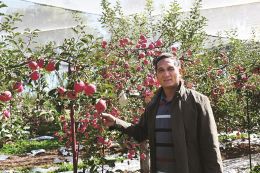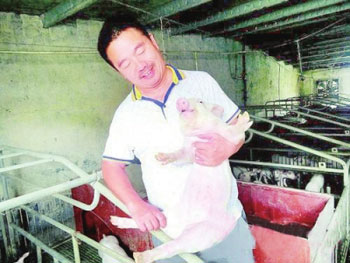Zhong Zhiming, an expert in aquaculture: a tireless aquatic person for 30 years.
In Zhaoxin Village, Baijiao Town, Doumen District, Zhuhai City, this small village famous for sea bass all over the country, mention Zhong Zhiming, no one knows, no one knows. During his 30 years of devoted aquaculture, he stepped from ambitious youth to successful middle age, not only owning 200 mu farm, but also managing fishery medicine and feed. Over the years he has devoted himself to white banana sea bass farming techniques, disease control and price trends. He is helpful and humble, and many of his local farming colleagues have received his help, which is why he is deeply recognized.
Standard "365" model breeding base
The demonstration pond was completed in June this year, and the stocking density of sea bass was 8200 fish/mu, which increased by 26% compared with the surrounding areas. In the past six months, the advantages of 365 model in high-density culture have been revealed. Traditional sea bass culture uses the principle of "U-shaped pipe" to feed water at high tide and drain water at low tide, but only part of the middle and upper water can be discharged, and organic matter precipitates to the bottom of the pond. Especially with the increase of feed amount in the later stage of culture, fish diseases occur frequently and the culture risk intensifies. The bottom sewage of the demonstration pond can effectively remove harmful substances at the bottom, and at the same time, it is matched with algae regulation, balanced oxygenation and other technologies to ensure the stability of water quality.
In the words of Boss Zhong,"The fast growth of fish is closely related to stocking density, scientific management, reasonable feeding and water quality control." At present, the feeding amount of the demonstration pond is controlled. It is planned to leave the pond around the Spring Festival. The yield per mu will not be lower than 12,000 jin. Compared with the control pond, the sea bass in the demonstration pond had higher fatness and lower ratio of organs to body through three sampling tests." Boss Zhong has a high evaluation of Tongwei,"Haiwei Company has undergone earth-shaking changes after joining Tongwei." Now, whether it's the quality of the feed or the various breeding technologies introduced, we can use them with confidence."
Preference for tail batch fish, yield 22,000 jin per mu
The experienced boss Zhong has his own considerations for selecting sea bass breeding batches,"the first batch of fish breeding cycle is short, the fish is fast, the price is high, but the feeding amount and yield per mu are correspondingly low; the price of the middle batch of fish is low, it is difficult to make money; the feeding amount of the last batch of fish is very large, and the price is also good. At the end of September this year, 120,000 catties of fish were produced from 5.5 mu sea bass pond released in January of 14 years, with a yield of about 22,000 catties per mu. Nearly 100 tons of feed were fed into 5.5 mu pond. Although the financial pressure and risk of raising tail batch fish are very high, the income is higher, because I am a dealer myself, and I am also considered a sales agent. 80% of the fish ponds raise tail batch fish."
Frequent observation, flexible water adjustment
Ammonia nitrogen and nitrite are the most serious threats to high-density sea bass culture. "Observe frequently, adjust water flexibly!"__ These seven words are Boss Zhong's summary of sea bass farming experience. "Haiwei company's service personnel go to the demonstration pond every week to measure the water quality, the normal pH value is 7.5~8, ammonia nitrogen is not higher than 0.4mg/l, sub-salt is not higher than 0.3mg/l (not higher than 0.2 in the later stage of cultivation)." When the water quality is not up to standard, I will first drain the bottom water with bottom sewage, then add new water, observe the water quality after routine disinfection, and then add reasonable algae control."
After 30 years of aquaculture, he witnessed the development of white banana sea bass farming and left his own gorgeous chapter in this history. In the future, he will continue to focus on sea bass farming and continue to write brilliant life!
- Prev

Niu encouraged himself to create the second revolution in apple production.
Niu encouraged himself to create the second revolution in apple production.
- Next

Let the pig live in an air-conditioned room, drink clean water and eat miscellaneous grains.
Let the pig live in an air-conditioned room, drink clean water and eat miscellaneous grains.
Related
- A course of planting techniques and methods on how to grow carrots
- How to plant the latest tulips?
- Is it better to pick tea in the morning or in the afternoon? When is the best time for tea to be picked? what is the third or fifth tea?
- Launch Yuanxiao Happy combination Haocha + Tea Yuan healthy Taste
- Penghu Tourism "Fireworks 20 Parade with You"
- 2022 West Lake Happiness holds "Digital Revitalization Voucher" and draws iphone13 and laptop.
- Banqiao Fuzhou social houses are designed to change start-up combined with police elimination to create a safe and livable environment
- The convenient measure of "mechanical weeding" in Xinbei has been abused and the Agriculture Bureau has imposed heavy penalties on the illegal land consolidation.
- Changgeng University Joins Hands with Four Memory Factories to Rescue Memory Talent Shortage
- The list of Taiwan's top 100 MVP managers is listed by the Director-General of the Farmers' Association of Sanxia District.

